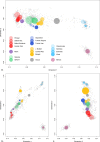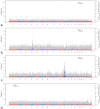Applications and efficiencies of the first cat 63K DNA array
- PMID: 29728693
- PMCID: PMC5935720
- DOI: 10.1038/s41598-018-25438-0
Applications and efficiencies of the first cat 63K DNA array
Erratum in
-
Author Correction: Applications and efficiencies of the first cat 63K DNA array.Sci Rep. 2018 Jun 4;8(1):8746. doi: 10.1038/s41598-018-26885-5. Sci Rep. 2018. PMID: 29867197 Free PMC article.
-
Author Correction: Applications and efficiencies of the first cat 63 K DNA array.Sci Rep. 2019 Mar 12;9(1):4664. doi: 10.1038/s41598-018-38073-6. Sci Rep. 2019. PMID: 30858384 Free PMC article.
Abstract
The development of high throughput SNP genotyping technologies has improved the genetic dissection of simple and complex traits in many species including cats. The properties of feline 62,897 SNPs Illumina Infinium iSelect DNA array are described using a dataset of over 2,000 feline samples, the most extensive to date, representing 41 cat breeds, a random bred population, and four wild felid species. Accuracy and efficiency of the array's genotypes and its utility in performing population-based analyses were evaluated. Average marker distance across the array was 37,741 Kb, and across the dataset, only 1% (625) of the markers exhibited poor genotyping and only 0.35% (221) showed Mendelian errors. Marker polymorphism varied across cat breeds and the average minor allele frequency (MAF) of all markers across domestic cats was 0.21. Population structure analysis confirmed a Western to Eastern structural continuum of cat breeds. Genome-wide linkage disequilibrium ranged from 50-1,500 Kb for domestic cats and 750 Kb for European wildcats (Felis silvestris silvestris). Array use in trait association mapping was investigated under different modes of inheritance, selection and population sizes. The efficient array design and cat genotype dataset continues to advance the understanding of cat breeds and will support monogenic health studies across feline breeds and populations.
Conflict of interest statement
The authors declare no competing interests.
Figures





References
-
- APPMA. National Pet Owner’s Survey. (American Pet Product Manufacturing Association 2008).
-
- AVMA. US Pet Ownership and Demographics Sourcebook. (American Veterinary Medical Association 2007).
-
- Nicholas, F. W., Brown, S. C. & Le Tissier, P. R. Online Mendelian Inheritance in Animals, OMIA, http://omia.angis.org.au (1998).
-
- Sunquist, M. S. F. Wild Cats of the World. (University of Chicago Press 2002).
-
- Nowak, R. M. Walker’s Mammals of the World. (The Johns Hopkins University Press 1999).
Publication types
LinkOut - more resources
Full Text Sources
Other Literature Sources
Miscellaneous

